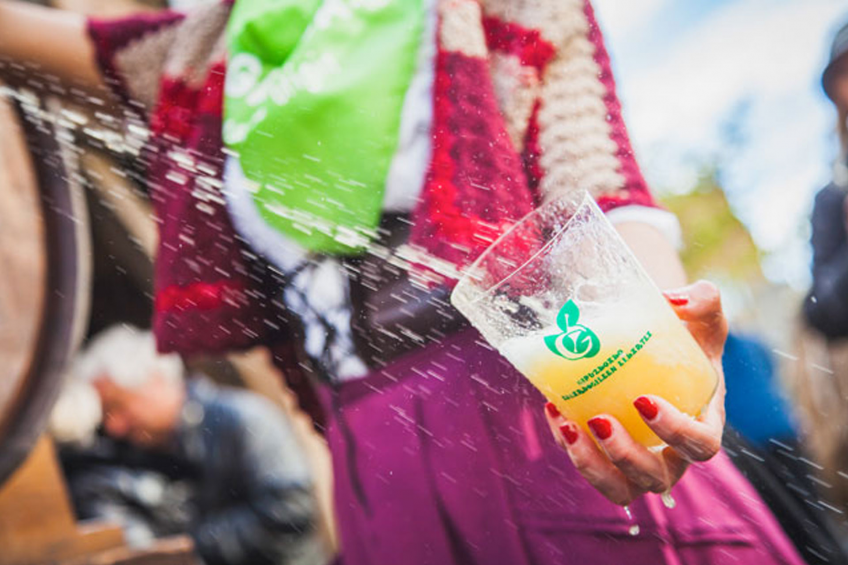Basque Cider World
Basque cider is a refreshing, natural product with a rich tradition. 500 years ago it was made on farms here, but today it is produced in our cider breweries in the traditional way but using innovative methods. In a bottle of cider you can find a family, a farm, an occupation, a way of life, a language, Basque culture, apple trees and the landscape and history of the Basque Country.

As well as making natural cider, diversification, innovation and product improvement are a constant part of today's cider breweries, which produce cider with the Euskal Sagardoa designation of origin, organic cider, sparkling natural cider, aged ciders, Sagardoz cider and apple juices.
THE CIDER INDUSTRY
Cider has always been made in Basque territory, but it reached a peak in the 16th century. Farm breweries spread all over the Basque Country to supply a society that was drinking more and more cider. Farmhouses have always been at the centre of cider making, and today coder makers have adapted to changing times with modern facilities but still serve cider in bottles and from the barrel, with the ritual of "txotx" and traditional cider house food. They combine past and present, passing on to future generations what they have learned from those who came before them. There are no known data for determining the origin of the apple and cider in the Basque Country. However, it is true that cider has been one of the most usual drinks in Basque farmhouses for centuries. There are several theories on the introduction of the apple in our territory. Some point towards it being introduced from Africa. A more wide spread idea is that it was the Arabs who brought the apple for the first time, others think that it is the result of the migration of birds transporting apple pips from far off Eastern lands and some say that the Basques learnt the art of producing cider from the Romans. However, some people say that the apple appears in the Basque territory spontaneously. Therefore, there are several and very different theories on the origin of the apple, and so, on cider production in our country. To demonstrate this, here are a few examples to get an idea of the origin and age of this tree in our territory
BASQUE CELLAR FARM
We owe great part of our culture to cider, that must be said. Apart from being an everyday beverage for the population, it was the beverage of our sailors and fishermen, who used to go after cod and whale all over the North Atlantic. The contracts clearly stated: for each sailor two or three apple cider liters a day. Thanks to cider, our sailors did not suffer the horrible illness scurvy, which made our sailors famous. This made it possible the exporting of the so acclaimed Basque iron and other materials.
The first Basque farms are built just to quench that enormous necessity of cider. They were huge companies to produce cider. In the golden age of Basque farms (XVIth century), their building was started with the "tolare", cellar in Basque. From that on, the rest of the facilities were built. That's why they are known as "tolare-baserriak" (cellar farms in Basque).
TXOTX RITUAL
In the "tolare sagardotegiak", season starts in January and ends in mid-May, but some cider houses nowadays open all year round. This mentioned season we can taste cider "txotx" style, straight from the barrels, and also in bottle, together with a traditional menu: cod omelette, fried cod with peppers and grilled T-bone steak. In all "tolare" cider houses, tradition says that "sagardogile" opens a "kupela" shouting "txotx", "txurrut" or "mojón". By holding the glass in the right way the visitors are able to serve themselves the cider, so that they can obtain the spark and appreciate the color, aroma and taste of the cider.
The "txotx" ritual began as a private tasting for wholesale buyers who went to cider houses for tasting the cider and choosing between different barrels. Over time, it was opened to public participation, until it became a winter and spring gastronomic event in the Basque land.
FUTURE
The future of cider will be guaranteed by three important pillars: the quality of the raw material, the product and the production process. The quality of the raw material will signify looking for the best for the product, which will imply promoting the native apple. As regards product quality, the quality of the product, the presentation and packaging, etc. must be looked for.
Finally, the quality of the production processes must be stressed, putting special emphasis on hygiene, the control of conditions such as the temperature, microbiological analysis, etc., monitoring and measuring the process and the adaptation of the product to the criteria marked by the clients.



Comentarios
Deje su comentario